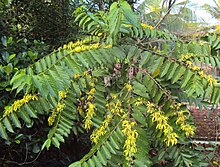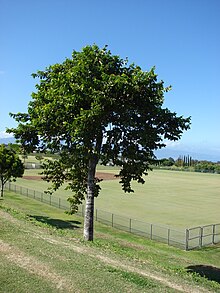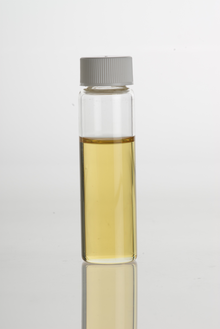| Ylang-ylang | |
|---|---|

| |
| Cananga odorata in bloom | |
| Scientific classification | |
| Kingdom: | Plantae |
| Clade: | Tracheophytes |
| Clade: | Angiosperms |
| Clade: | Magnoliids |
| Order: | Magnoliales |
| Family: | Annonaceae |
| Genus: | Cananga |
| Species: | C. odorata |
| Binomial name | |
| Cananga odorata (Lam.) Hook.f. & Thomson | |

Cananga odorata, known as ylang-ylang (/ˈiːlæŋ ˈiːlæŋ/ EE-lang-EE-lang) or cananga tree, is a tropical tree that is native to the Philippines, Malaysia, Indonesia, New Guinea, the Solomon Islands, and Queensland, Australia. It is also native to parts of Thailand and Vietnam. It is valued for the essential oils extracted from its flowers (also called "ylang-ylang"), which has a strong floral fragrance. Ylang-ylang is one of the most extensively used natural materials in the perfume industry, earning it the name "Queen of Perfumes".
The climbing ylang-ylang vine, Artabotrys hexapetalus (synonym A. odoratissimus) is a woody, evergreen climbing plant in the same family, which is also a source of perfume.
Etymology and nomenclature
The name ylang-ylang is the Spanish spelling of the Tagalog term for the tree, ilang-ilang - a reduplicative form of the word ilang, meaning "wilderness", alluding to the tree's natural habitat. A common mistranslation is "flower of flowers".
The tree is also called the fragrant cananga, Macassar-oil plant, or perfume tree. It is called kenanga in Malay, from Proto-Malayo-Polynesian *kanaŋa. Its traditional Polynesian names include mataʻoi (Cook Islands), mohokoi (Tonga), mosoʻoi (Samoa), motoʻoi (Hawaii), and mokosoi, mokasoi or mokohoi (Fiji). Other traditional names include sampangi (Telugu).
Description

Cananga odorata is a fast-growing tree of the custard apple family Annonaceae. Its growth exceeds 5 m (16 ft) per year, and it attains an average height of 12 m (39 ft) in an ideal climate. The compound evergreen leaves are pinnate, smooth and glossy, and 13–21 cm (5–8.5 in) long. Leaflets are oval, pointed and with wavy margins. The flower is drooping, long-stalked, with six narrow, greenish-yellow (rarely pink) petals, rather like a sea star in appearance, and yields a highly fragrant essential oil. Its pollen is shed as permanent tetrads.
Cananga odorata var. fruticosa, dwarf ylang-ylang, grows as small tree or compact shrub.
Distribution and habitat
The plant is native to Maritime Southeast Asia and Near Oceania, from the Philippines, Malaysia, Indonesia, New Guinea, the Solomon Islands, and Queensland, Australia. It is also native to parts of Thailand, and Vietnam. It has been introduced to other tropical regions in the Pacific Islands, South Asia, Africa, and the Americas. It is commonly grown in Madagascar, Polynesia, Melanesia, Micronesia, and the Comoros Islands. It grows in full or partial sun, and prefers the acidic soils of its native rainforest habitat. Ylang-ylang has been cultivated in temperate climates under conservatory conditions.
In Madagascar, it is grown in plantations with Hewittia malabarica (L.) Suresh as a groundcover plant.
Ecology
Its clusters of black fruit are an important food item for birds, such as the collared imperial pigeon, purple-tailed imperial pigeon, Zoe's imperial pigeon, superb fruit dove, pink-spotted fruit dove, coroneted fruit dove, orange-bellied fruit dove, and wompoo fruit dove. The Sulawesi red-knobbed hornbill serves as an effective seed disperser for C. odorata.
Uses
| This section needs additional citations for verification. Please help improve this article by adding citations to reliable sources in this section. Unsourced material may be challenged and removed. Find sources: "Cananga odorata" – news · newspapers · books · scholar · JSTOR (January 2025) (Learn how and when to remove this message) |
The essential oil is used in aromatherapy. It is believed to relieve high blood pressure and normalize sebum secretion for skin problems, and is considered to be an aphrodisiac. The oil from ylang-ylang is widely used in perfumery for oriental- or floral-themed perfumes (such as Chanel No. 5). Ylang-ylang blends well with most floral, fruit, and wood scents.
In Indonesia, ylang-ylang flowers are spread on the bed of newlywed couples. In the Philippines, its flowers, together with the flowers of the sampaguita, are strung into a necklace (lei) and worn by women and used to adorn religious images.
Ylang-ylang's essential oil makes up 29% of the Comoros' annual export (1998).
Ylang-ylang is grown in Madagascar and exported globally for its essential oils.
Ylang-ylang essential oil is one of the basic ingredients of macassar oil.
Ylang-ylang essential oil

Characteristics
The fragrance of ylang-ylang is rich and deep with notes of rubber and custard, and bright with hints of jasmine and neroli, thus it is sometimes described as heavy, sweet, and carries a slightly fruity floral scent. The essential oil of the flower is obtained through steam distillation of the flowers and separated into different grades (extra, 1, 2, or 3) according to when the distillates are obtained. The main aromatic components of ylang-ylang oil are benzyl acetate, linalool, p-cresyl methyl ether, and methyl benzoate, responsible for its characteristic odor.
Chemical constituents
Typical chemical compositions of the various grades of ylang-ylang essential oil are reported as:
- Linalool
- Germacrene
- Geranyl acetate
- Caryophyllene
- p-Cresyl methyl ether
- Methyl benzoate
- Sesquiterpenes
See also
- Jasminum sambac, the Arabian jasmine, another plant widely used in perfumes
- Domaine Ylang Ylang
References
- ^ "Cananga odorata (Lam.) Hook.f. & Thomson". Plants of the World Online. Royal Botanic Gardens, Kew. Retrieved 2019-02-11.
- NPCS Board of Consultants & Engineers (2007). The Complete Technology Book on Flavours, Fragrances and Perfumes. Niir Project Consultancy Services. p. 392. ISBN 9788190439886.
- Landers, G.J.B. (1992). "The effect of social and economic changes and trens in fashion and their effects on international perfumery marketing". In Van Toller, S.; Dodd, G.H. (eds.). Fragrance: The psychology and biology of perfume. Elsevier Science Publishers Ltd. p. 268. ISBN 9781851668724.
- Duke, James A. (2018). Handbook of Medicinal Herbs: Herbal Reference Library. CRC Press. ISBN 9781351089579.
- "Tropicos". Tropicos. Retrieved 2012-12-30.
- ^ "ylang-ylang". Encyclopædia Britannica. Retrieved 2012-12-30.
- English, Leo James (1987). Tagalog-English Dictionary. Congregation of the Most Holy Redeemer/National Bookstore, Manila. p. 685 ISBN 9789710844654
- "University of Melbourne: multilingual plant names database". Plantnames.unimelb.edu.au. 2004-08-05. Retrieved 2012-12-30.
- p. 12 In: Vanoverbergh, Morice (1968). Iloko-English Dictionary:Rev. Andres Carro's Vocabulario Iloco-Español. Catholic School Press, Congregation of the Immaculate Heart of Mary, Baguio City, Philippines. 370pp.
- Blust, Robert; Trussel, Stephen (2010). "*kanaŋa a tree with fragrant flowers: Cananga odorata". Austronesian Comparative Dictionary. Max Planck Institute for Evolutionary Anthropology. Retrieved 8 November 2022.
- "Cook Island Biodiversity and Natural Heritage". 2007. Archived from the original on 2 December 2005. Retrieved 18 June 2016.
- "Cananga odorata - Ylang Ylang". www.flowersofindia.net. Retrieved 2023-12-30.
- Walker JW (1971) Pollen Morphology, Phytogeography, and Phylogeny of the Annonaceae. Contributions from the Gray Herbarium of Harvard University, 202: 1-130.
- ^ G. J. H. Grubben and O.A. Denton Plant Resources of Tropical Africa 2;Vegetables (2004), p. 311, at Google Books
- Royal Berglee, PhD (17 June 2016). "13.1 The Pacific Islands". World Regional Geography: People, Places and Globalization. Archived from the original on 2 July 2017. Retrieved 6 February 2024.
- Frith, H.J.; Rome, F.H.J.C. & Wolfe, T.O. (1976): Food of fruit-pigeons in New Guinea. Emu 76(2): 49-58. HTML abstract
- Kinnaird, Margaret F. (1998). "Evidence for Effective Seed Dispersal by the Sulawesi Red-Knobbed Hornbill, Aceros cassidix1". Biotropica. 30 (1): 50–55. Bibcode:1998Biotr..30...50K. doi:10.1111/j.1744-7429.1998.tb00368.x. S2CID 84282134.
- "Production of ylang ylang flowers under threat in Comoros?". Premium Beauty News. Retrieved 2022-04-26.
- "Essential oils from Madagascar, essences coveted for their origin". EDBM (in French). 2020-07-22. Retrieved 2022-04-26.
- Manner, Harley and Craig Elevitch,Traditional Tree Initiative: Species Profiles for Pacific Island Agroforestry (2006), Permanent Agricultural Resources, Honolulu, Hi.
- "Ylang-Ylang Essential Oil - Chemical Composition". scienceofacne.com. Archived from the original on 2012-04-14. Retrieved 2012-02-26.
Further reading
- Elevitch, Craig (ed.) (2006): Traditional Trees of Pacific Islands: Their Culture, Environment and Use. Permanent Agricultural Resources Publishers, Honolulu. ISBN 0-9702544-5-8
- Manner, Harley & Elevitch, Craig (ed.) (2006): Traditional Tree Initiative: Species Profiles for Pacific Island Agroforestry. Permanent Agricultural Resources Publishers, Honolulu.
- Davis, Patricia (2000): "Aromatherapy An A-Z". Vermilion:Ebury Publishing, London.
External links
 Data related to Cananga odorata at Wikispecies
Data related to Cananga odorata at Wikispecies- Ylang ylang uses in perfumery
| Taxon identifiers | |
|---|---|
| Cananga odorata |
|
| Uvaria odorata | |